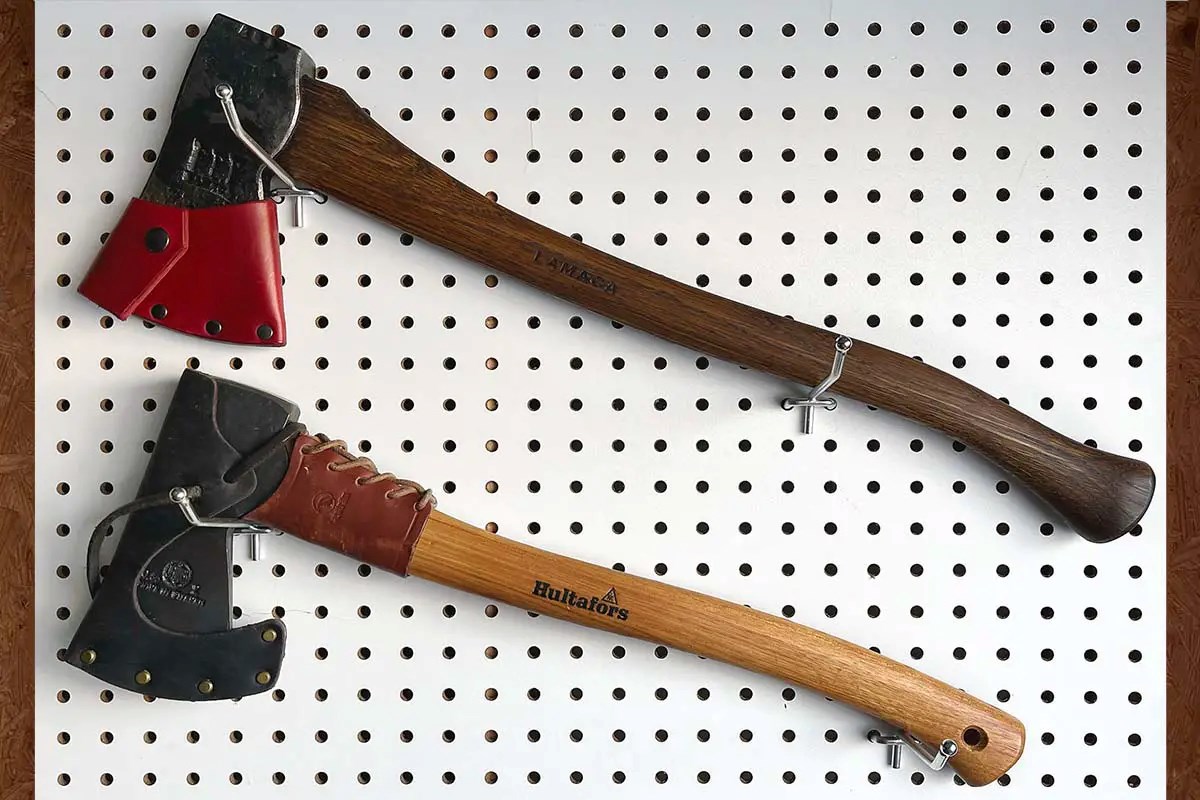

Articles
How To Store Axes
Modified: October 27, 2024
Discover expert tips and techniques for storing and maintaining your axes with our informative articles. Ensure your axes stay in top condition for years to come.
(Many of the links in this article redirect to a specific reviewed product. Your purchase of these products through affiliate links helps to generate commission for Storables.com, at no extra cost. Learn more)
Introduction
Welcome to our guide on how to store axes properly. Whether you use your axe for chopping firewood, clearing brush, or other outdoor tasks, proper storage is essential to maintain its quality and longevity. Axes are valuable tools that can last for many years if they’re stored correctly. In this article, we will provide you with valuable insights and tips on how to store your axes to keep them in optimal condition.
When it comes to storing axes, several factors need to be taken into consideration, including the storage location, cleaning and maintenance, protective measures for axe blades, securing axe handles, and long-term storage. By following these guidelines, you can prevent damage, rust, and other issues that may affect the performance and lifespan of your axes.
Whether you store your axes indoors or outdoors, the aim is to create an environment that is dry, clean, and secure. By doing so, you’ll protect the axe head from rust, prevent the handle from warping or cracking, and ensure your axe is ready for use whenever you need it.
Now, let’s dive deeper into the steps you can take to store your axes properly, starting with choosing the right storage location.
Key Takeaways:
- Properly storing axes is crucial for maintaining their quality and longevity. Choose a dry, well-ventilated storage location, clean and maintain axes regularly, and implement protective measures to prevent rust and damage.
- Whether storing axes indoors or outdoors, prioritize securing axe handles, regular inspection, and maintenance. For long-term storage, clean, lubricate, and store axes in a dry environment to ensure they remain in excellent condition for years to come.
Read more: How To Use Axe Air Freshener
Choosing the Right Storage Location
When selecting a storage location for your axes, it’s important to consider factors such as temperature, humidity levels, and exposure to sunlight. Ideally, you want to choose a place that is dry, well-ventilated, and protected from extreme temperatures.
Avoid storing your axes in areas that are prone to moisture, such as damp basements or crawl spaces, as this can lead to rust formation on the axe head. Extreme temperatures, especially in the case of freezing temperatures, can also cause damage to the handle, leading to cracking or warping.
If possible, find a storage area that offers stable temperature and humidity conditions. A shed or garage with climate control is an excellent option. If you don’t have access to such a space, consider using a plastic or metal storage container that provides protection against moisture and extreme temperatures.
Another important aspect to consider is the security of the storage location. If you have valuable or expensive axes, ensure that the storage area is secure and inaccessible to unauthorized individuals to prevent theft.
Lastly, keep in mind the convenience and accessibility of the storage location. Make sure the axes are easily accessible when you need them, whether it’s for routine maintenance or when you have an outdoor task at hand.
Now that you have chosen the right storage location, let’s move on to the next step: cleaning and maintaining your axes.
Cleaning and Maintaining Axes
Proper cleaning and maintenance are crucial for keeping your axes in good condition and preventing rust and other forms of damage. Here are some steps you can follow:
- Remove any dirt or debris: Before cleaning your axe, remove any dirt, sawdust, or other debris from the blade and handle. You can use a brush or a cloth to gently wipe away the loose particles.
- Clean the axe blade: To clean the blade, use a mild soap or detergent mixed with warm water. Gently scrub the blade using a soft-bristle brush or a cloth. Be sure to clean the entire surface, including the cutting edge and the sides of the blade. Rinse off the soap residue with clean water and dry the blade thoroughly.
- Lubricate the axe head: After cleaning, it’s essential to apply a thin coat of lubricant or oil to the blade to prevent rust formation. You can use a product specifically designed for tool maintenance, or even a light coat of mineral oil or vegetable oil. Apply the oil with a cloth, ensuring that all surfaces of the blade are covered.
- Clean and condition the axe handle: The handle of your axe also requires attention. Wipe the handle with a cloth dampened with a mixture of mild soap and water. Rinse off the soap residue and dry the handle completely. Apply a coat of wood conditioner or paste wax to protect and moisturize the wood, preventing it from drying out or cracking.
- Inspect for damage: While cleaning your axe, take the opportunity to inspect the blade and the handle for any signs of damage. Look for chips, cracks, or splintering in the wood handle, and check for any nicks or breaks in the blade. If you notice any issues, it’s important to address them before storing the axe.
By following these cleaning and maintenance steps on a regular basis, you can ensure that your axes remain in optimal condition and ready for use whenever you need them. Now, let’s move on to the next section, where we’ll explore protective measures for axe blades.
Protective Measures for Axe Blades
Protecting the blade of your axe is essential to prevent rust, corrosion, and potential damage. Here are some protective measures you can take:
- Apply a rust inhibitor: After cleaning and drying the axe blade, consider applying a rust inhibitor or protective coating. There are various products available on the market specifically designed to prevent rust formation on metal surfaces. Follow the manufacturer’s instructions for application and ensure that the entire blade, including the cutting edge, is covered.
- Use a blade cover: Another effective way to protect the axe blade is by using a blade cover. These covers, usually made of sturdy materials like leather or heavy-duty plastic, provide a physical barrier to shield the blade from moisture, dust, and other potential sources of damage. Ensure that the cover fits properly and securely over the blade.
- Store the axe vertically: When storing your axes, it is best to store them vertically with the blade facing upward. This position not only prevents the blade from coming into contact with other objects, but it also allows any moisture or condensation to drain away from the blade, reducing the risk of rust formation.
- Avoid storing axes in moist or humid environments: As mentioned earlier, moisture is the enemy of axe blades, as it can lead to rust formation. Avoid storing your axes in areas with high humidity or excessive moisture, such as damp basements or areas near water sources.
- Regularly inspect and clean the blade: Make it a habit to periodically inspect the blade of your axe. Look for any signs of rust, discoloration, or damage. If you notice any issues, clean and address them promptly to prevent further deterioration.
By implementing these protective measures, you can significantly extend the lifespan of your axe blades and keep them in optimal condition. Next, we will explore the importance of securing axe handles during storage.
Securing Axe Handles
Securing the handles of your axes is crucial to prevent them from warping, cracking, or becoming loose during storage. Here are some steps you can take to ensure the security of your axe handles:
- Inspect the handle for any looseness: Before storing your axe, inspect the handle to ensure there are no signs of looseness or instability. If you notice any wobbling or movement, it’s essential to address it before storing the axe. Tighten any loose screws or bolts and make sure the handle is securely attached to the axe head.
- Store the axe in an upright position: When storing your axe, it’s best to store it in an upright position, with the handle resting on the ground or a stable surface. Avoid leaning the axe against a wall or another object, as this can cause unnecessary strain on the handle and lead to warping or deformation.
- Consider using axe racks or holders: If you have multiple axes or need to store them in a compact space, using axe racks or holders can be beneficial. These racks are designed to securely hold the axes in an upright position, preventing them from falling or shifting during storage. Make sure the racks are sturdy and properly installed.
- Avoid placing heavy objects on top of the axe handles: During storage, it’s important to avoid placing heavy objects on top of the axe handles, as this can cause them to bend or deform over time. Keep the area where you store your axes free from clutter and ensure that nothing is resting on the handles.
- Protect the handles from extreme temperatures: Extreme temperatures can have a detrimental effect on the handles of your axes. Avoid storing them in areas that are subject to extreme heat or cold, as this can cause the wood to expand or contract, leading to cracks or warping. If necessary, consider using insulation or a protective cover for added temperature regulation.
By following these measures to secure your axe handles, you can maintain the integrity and functionality of the handles, ensuring that your axes are always ready for use. Next, we will explore the options available for storing axes indoors.
To store axes, clean and dry the blade before applying a light coat of oil to prevent rust. Store in a dry place, hanging or standing upright to prevent damage to the blade or handle.
Read more: How To Store Store-Bought Bread
Storing Axes Indoors
Storing your axes indoors provides an added level of protection from the elements and ensures convenient access whenever you need them. Here are some tips to consider when storing axes indoors:
- Choose a suitable storage area: Select a dry, well-ventilated area in your home, such as a garage, shed, or workshop, to store your axes. Avoid areas with excessive humidity or moisture, as this can lead to rust formation on the axe blades.
- Hang the axes on a wall or a pegboard: One popular method for storing axes indoors is hanging them on a wall or a pegboard. This keeps them off the ground and minimizes the risk of damage. Install sturdy hooks or pegs at appropriate intervals to hang the axes securely. Make sure to hang them vertically with the blade facing upward.
- Use a rack or a stand: If you prefer to keep your axes in a specific area, consider using a rack or a stand designed for axe storage. These racks provide stability and prevent the axes from accidentally tipping over. Make sure the rack or stand is placed in a secure location to avoid any potential accidents.
- Keep the axes clean and dry: Before storing the axes indoors, ensure they are clean and dry. Follow the cleaning and maintenance steps mentioned earlier in this guide to remove any dirt or moisture from the blades and handles. Remember to apply a thin coat of lubricant to the blades to prevent rust formation.
- Consider using a protective cover: If you’re storing your axes indoors and want to offer an extra layer of protection, consider using a protective cover. Leather or canvas sheaths are commonly used to cover the axe blades and prevent accidental cuts or damage to other items in the storage area. Make sure the cover fits securely over the blade.
By following these tips, you can safely store your axes indoors, keeping them in optimal condition for extended periods. Next, let’s explore the options for storing axes outdoors.
Storing Axes Outdoors
If you need to store your axes outdoors, it’s crucial to take additional precautions to protect them from the elements. Here are some tips for storing axes outdoors:
- Choose a covered storage area: When storing your axes outdoors, aim to find a covered storage area such as a shed or a storage box with a weather-resistant cover. This will provide protection from rain, snow, and excessive sunlight, minimizing the risk of rust formation and damage to the handles.
- Elevate the axes off the ground: To prevent moisture from seeping into the handles or collecting around the axe heads, elevate the axes off the ground. You can use wooden pallets or DIY stands to keep the axes raised and ensure proper air circulation around them.
- Secure the axes: It’s essential to secure the axes outdoors to prevent theft or damage caused by strong winds. Consider using a lock or a chain to attach the axes to a fixed object, such as a sturdy post or a wall, ensuring they cannot be easily moved or stolen.
- Cover the axes with a waterproof tarp: Even if stored in a covered area, it’s a good idea to further protect the axes by covering them with a waterproof tarp. This will provide an extra layer of protection from rain, snow, and other environmental factors that may cause damage to the axes.
- Inspect and maintain regularly: Outdoor storage exposes axes to a harsher environment, so it’s crucial to inspect and maintain them regularly. Check for any signs of rust, damage, or loose parts, and address them promptly to prevent further deterioration.
Remember that storing axes outdoors may lead to quicker wear and tear compared to indoor storage, given the exposure to the elements. Therefore, it’s advisable to store your axes indoors whenever possible to maximize their longevity. If outdoor storage is the only option, be diligent in following these tips to minimize potential damage. Finally, let’s explore considerations for long-term storage of axes.
Storing Axes for Long-Term
When storing axes for an extended period, such as during the off-season or if you won’t be using them for an extended period, it’s crucial to take extra care to ensure they remain in good condition. Here are some tips for long-term axe storage:
- Thoroughly clean and lubricate the axes: Before storing your axes for the long-term, make sure to clean them thoroughly following the steps mentioned earlier in this guide. Remove any dirt, debris, or rust and apply a generous coat of lubricant to the blades to prevent further rust formation during storage.
- Inspect for damage: Take the time to inspect the axe heads and handles for any signs of damage. Repair any chips, cracks, or splintering in the wood handles, and sharpen or restore the cutting edge of the blades if necessary. It’s advisable to address any damage before storing the axes for an extended period.
- Wrap the axes in protective material: To provide an extra layer of protection, wrap the axes in protective material such as a soft cloth or paper towels. This will help prevent dust, moisture, and other contaminants from coming into contact with the axe heads or handles.
- Store the axes in a dry and controlled environment: Ideal long-term storage for axes is in a dry and controlled environment, such as a climate-controlled room or a storage box with a dehumidifier. Keeping the axes away from humidity and extreme temperature fluctuations will help prevent rust and wood damage.
- Avoid stacking or placing heavy objects on the axes: During long-term storage, avoid stacking or placing heavy objects on top of the axes, as this can lead to bending, warping, or other forms of damage. Keep the storage area free from any unnecessary weight or pressure on the axes.
- Periodically inspect and maintain: While in long-term storage, it’s important to periodically inspect the axes. Check for any signs of rust, damage, or loose parts. If necessary, clean and lubricate the blades, and ensure the handles remain secure and intact.
By following these tips, you can keep your axes in excellent condition during long-term storage, ensuring they are ready for use whenever you need them. It’s essential to maintain regular maintenance and inspection even during storage to address any issues promptly. Finally, let’s wrap up this guide on storing axes properly.
Conclusion
Properly storing your axes is essential for maintaining their quality, longevity, and optimal performance. By following the guidelines outlined in this article, you can ensure that your axes remain in excellent condition and are ready for use whenever you need them.
Choosing the right storage location is the first step. Find a dry, well-ventilated area with stable temperature and humidity levels. Keep the axes away from moisture and extreme temperatures to prevent rust formation and handle damage.
Cleaning and maintaining your axes regularly is crucial. Remove dirt, debris, and rust from the blades. Lubricate the blades and condition the handles to prevent drying out and cracking. Inspect for any damage and address it promptly.
Protective measures for axe blades are essential to prevent rust and damage. Use rust inhibitors, blade covers, and store the axes vertically to minimize contact with other objects and ensure proper drainage.
Securing axe handles helps prevent warping, cracking, and instability. Store the axes in an upright position, consider using racks or holders, and avoid placing heavy objects on top of the handles.
Storing axes indoors offers additional protection and convenience. Hang them on walls or use racks, and ensure the storage area is dry and well-ventilated.
If storing axes outdoors, choose a covered area, elevate them off the ground, secure them, and use waterproof covers. Regular inspection and maintenance are important to address any issues promptly.
For long-term storage, clean and lubricate the axes, wrap them in protective material, store in a dry environment, and periodically inspect and maintain them.
By following these guidelines and investing the time and effort in proper storage, you can ensure that your axes remain in excellent condition for years to come. Remember to inspect and maintain them regularly, even during storage, to address any issues promptly. With proper care, your axes will be reliable tools whenever you need them.
Frequently Asked Questions about How To Store Axes
Was this page helpful?
At Storables.com, we guarantee accurate and reliable information. Our content, validated by Expert Board Contributors, is crafted following stringent Editorial Policies. We're committed to providing you with well-researched, expert-backed insights for all your informational needs.















0 thoughts on “How To Store Axes”